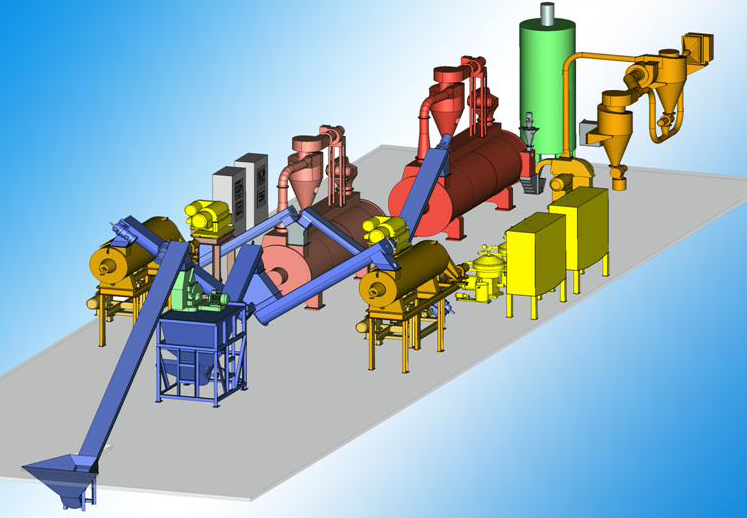Our factory produces technological equipment that meets the highest technical requirements for fish processing industry of foreign countries and the countries of the CIS. Having qualified specialists the factory has every opportunity to manufacture technological equipment for fish meal production according to an individual order of the customer. Our factory designed and mastered the production of the new fishmeal and oil unit RMU-120 for processing 120 ton of raw material. While designing it long-term experience of the previous units’ work as well as all the comments and suggestions of the customers have been taken into account. It is intended for production of fish meal and cod-liver oil from fish waste and less valuable breeds of fish in large costal fish processing factories. High level of dehydration in cooked fish mass provides less dryer load that lowers energy expenditures for drying. Heating losses during raw material taking from one aggregate to another are reduced to a minimum. Due to usage of screw presses and rotor-disk dryers a simple construction is achieved as well as high reliability of the units which is very important for any production process. Obvious merit of modern equipment produced by our factory is the fact that it is relatively inexpensive in comparison with foreign analogues of Germany, Denmark, Holland, but it is reliable in operation. Function: Fishmeal and oil unit RMU-120 is intended for production of fish meal and cod-liver oil from fish waste and less valuable breeds of fish. It is installed in large costal fish processing complexes and factories.

Technical characteristics
1. Productive capacity (of raw material), tons per day........................120
2. Operation...............................................................................continuous
3. The size of raw materialPieces with mass of not more than........10kg
4. The quantity of fishmeal, obtained from raw material, ............%18-22
5. Steam pressure, Pa (kg/sm2).................................................5·105 (5)
6. Steam consumption without vacuum-evaporating system,.kg/hr 2600
7. Fresh water or brine amount (5o C) for cooling fishmeal,./kg/hr 2000
8. Fresh water consumption of separator, m3/hr .........................max0,1
9. Total engine power, kwt, ..........................................................max185
10. Final product obtained...............Fishmeal and technical cod-liver oil
11. Dimension, mm, ............................................max31000х9000х5000
12. Weight (mass), kg, .............................................................max47000
2. Operation...............................................................................continuous
3. The size of raw materialPieces with mass of not more than........10kg
4. The quantity of fishmeal, obtained from raw material, ............%18-22
5. Steam pressure, Pa (kg/sm2).................................................5·105 (5)
6. Steam consumption without vacuum-evaporating system,.kg/hr 2600
7. Fresh water or brine amount (5o C) for cooling fishmeal,./kg/hr 2000
8. Fresh water consumption of separator, m3/hr .........................max0,1
9. Total engine power, kwt, ..........................................................max185
10. Final product obtained...............Fishmeal and technical cod-liver oil
11. Dimension, mm, ............................................max31000х9000х5000
12. Weight (mass), kg, .............................................................max47000
Operation
Fish raw material is taken into the chopper (2) by the loading screw conveyer (1). Crushed raw material passes from the chopper into the bunker with screw conveyer dozer (3) and then to the bunker of screw conveyer dozers (5). From this bunker two screw conveyer dozers (6) send fish raw material to the cookers (7). From the cooker boiled mash passes along the chute to the screw conveyer press (9) where liquor and oil are pressed out of boiled mash, then oil and liquor are pumped to the centrifuge of the slime exudation unit (20). Pressed out bagasse is taken to the dryer of preparatory drying (13) by two screw conveyers (11). Right there along screw conveyers slime, squeezed out of the liquor by centrifuges, is added. The purified liquor after the centrifuge (20) is transported to the two-section tank (21) for residue and heating. The tank sections operate in turn depending on the level of filling and heating up. The heated liquor goes further to the separator (22) that separates oil from liquor. The separator is automatic and self-unloading. Separated oil is taken to the pumping unit from where it is pumped into the oil collector while the purified and defatted liquor passes to the collector or a sewage disposal. After the preparatory drying (13) the bagasse is taken to the complete final drying dryer (15) with the help of the screw conveyer (14) Dried meal passes from the discharging chute of the dryer to the magnetic device where metal impurities are caught by the permanent magnets. Dried meal is mixed with antioxidant fed by the ionol feeder (16) in the discharging chute. From the magnetic device dried meal is sucked into the milling machine where it is crushed and together with air passes to the centrifugal discharger (cyclone) of the pneumatic transport (19) where the meal is separated from the air. From the discharger the meal goes through the sluice gate into the air conduit where it is cooled being mixed with the cooled air brought by the air cooler and then taken to the second cyclone by the flow of air. Through the second cyclone the meal goes into the slice gate and then into the meal bag packing device. The air from cookers, dryers and cyclones goes to the deodorizing system (25) where it is completely purified from dust and impurities. The aggregates switching on and off, adjustment and control of the operating regimes are done from the central control panel (24).
Technical scheme of the Unit RMU-120


